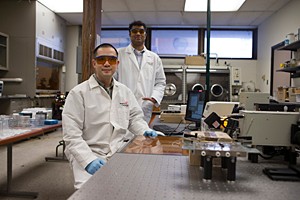
UC Researchers Report on Discovery to Make Solar Power Less Expensive and More Efficient
University of Cincinnati researchers are reporting early results on a way to make solar-powered panels in lights, calculators and roofs lighter, less expensive, more flexible (therefore less breakable) and more efficient.
Fei Yu, a University of Cincinnati doctoral student in materials engineering, will present new findings on boosting the power conversion efficiency of polymer solar cells on March 3, at the American Physical Society Meeting in Denver.
Yu is experimenting with adding a small fraction of graphene nanoflakes to polymer-blend bulk-heterojunction (BHJ) solar cells to improve performance and lower costs of solar energy.
There has been a lot of study on how to make plastic solar cells more efficient, so they can take the place of silicon solar cells in the future, says Yu. They can be made into thinner, lighter and more flexible panels. However, theyre currently not as efficient as silicon solar cells, so were examining how to increase that efficiency.
Imagine accidentally kicking over a silicon solar-powered garden light, only to see the solar-powered cell crack. Polymers are carbon-based materials that are more flexible than the traditional, fragile silicon solar cells. Charge transport, though, has been a limiting factor for polymer solar cell performance.

Fei Yu (
Graphene, a natural form of carbon, is a relatively newly discovered material thats less than a nanometer thin. Because graphene is pure carbon, its charge conductivity is very high, explains Yu. We want to maximize the energy being absorbed by the solar cell, so we are increasing the ratio of the donor to acceptor and were using a very low fraction of graphene to achieve that.
Yus research found that efficiency increased threefold by adding graphene, because the material was helping to rapidly transport charges to achieve higher photocurrent. The increased performance, although well below the highest efficiency achieved in organic photovoltaic (OPV) devices, is nevertheless significant in indicating that pristine graphene can be used as a charge transporter, says Yu.
Yus advisor, Vikram K. Kuppa, an assistant professor in the School of Energy, Environmental, Biological and Medical Engineering (SEEBME) for the UC College of Engineering and Applied Sciences (CEAS), was a contributor to the research. Kuppa is leading the research of a variety of polymer-blend solar cells involving the use of graphene.
Future research will focus on device physics, film morphology and how to control and optimize these randomly distributed graphene nanoflakes by a variety of methods to achieve better performance.
The
meeting is the largest meeting of its kind in the world, and focuses on research from industry, universities and major labs. The meeting brings together nearly 10,000 physicists and students to share their groundbreaking research.
UCs College of Engineering and Applied Science
is a leader in engineering education, research and innovation, and is the world founder of cooperative education.
Related Stories
UC’s Ground Floor Makerspace births combat robots
April 17, 2024
In the heart of UC's 1819 Innovation Hub lies the Ground Floor Makerspace, an advanced and active hub of ingenuity where students, faculty and the community converge to bring their ideas to life. This includes being the birthplace of robots much like miniature race cars, combating fender to fender in an enclosed boxing ring. Combat robots like UC's Maximizer will again be fighting for first place in the National Havoc Robot League (NHRL) competition, slated for April 20.
UC researchers develop new CPAP device
April 17, 2024
Researchers at the University of Cincinnati are developing a VortexPAP machine that takes advantage of vortex airflow technology. A preliminary clinical study with current CPAP users demonstrated that the VortexPAP can deliver the pressure levels that are used in the subjects’ CPAP therapy, but the mask is more comfortable to wear. It has a minimalistic design that is less intrusive and barely touches the patient’s face.
UC architectural engineering alumna inspires high school students
April 16, 2024
University of Cincinnati alumna Emma Wilhelmus fell in love with engineering when she was in ninth grade. After taking drafting, architecture and engineering courses in high school, she set out to major in architectural engineering in college. Now, she is an engineering teacher at a local high school and hopes to inspire students.
